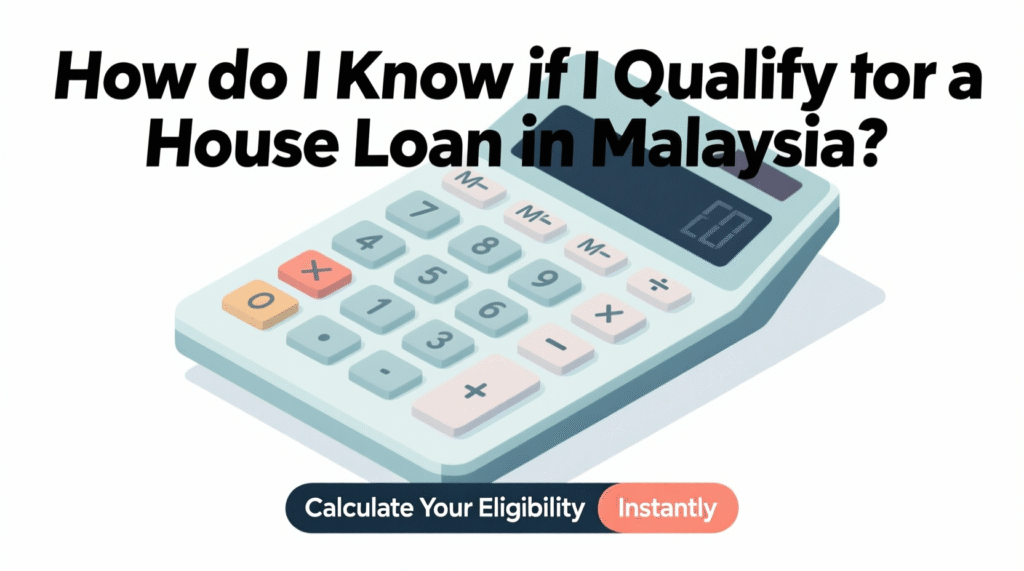
For many Malaysians, buying a home is a significant life goal. But a key question often arises: “How do I know if I qualify for a house loan in Malaysia?” This guide is designed to answer that question, providing a clear roadmap for prospective homebuyers, especially first-timers, to understand their eligibility. By the end, you’ll know exactly what banks look for and how to prepare for your application
The 3 Core Pillars of Home Loan Eligibility
To determine your eligibility, banks will primarily assess three crucial areas of your financial life.
1. Your Income and Employment Stability
Banks need to be confident you have a stable and sufficient income to make your monthly loan payments. They will verify your income and employment status with these documents:
- For Salaried Individuals:
- Latest 3 to 6 months of payslips
- Latest EPF statement
- Latest income tax return (Form B/BE)
- Letter of employment
- For Self-Employed Individuals:
- Business registration documents (SSM)
- Latest 6 months of company and personal bank statements
- Latest 2 years of income tax returns (Form B)
Why this matters: A stable income proves your capacity to repay the loan over the long term. Banks are more likely to approve applicants with consistent employment history.
2. Your Debt Service Ratio (DSR)
This is the most critical factor. Your Debt Service Ratio (DSR) is a percentage that shows how much of your net monthly income is already being used to service existing debt.
How to calculate your DSR:
DSR=Net Monthly IncomeTotal Monthly Commitments×100%
- Total Monthly Commitments include all existing loan payments (car loan, personal loan, credit card minimum payments).
- Net Monthly Income is your gross income minus mandatory deductions like EPF, SOCSO, and income tax.
Example Calculation:
- Scenario: You earn a gross monthly salary of RM5,000. After EPF and SOCSO, your net income is RM4,500. You have a car loan payment of RM800/month and credit card debt with a minimum payment of RM200/month.
- Your total monthly commitments: RM800 (car loan) + RM200 (credit card) = RM1,000.
- Your DSR: (RM4,500RM1,000)×100%=22.2%
A DSR below 60-70% is generally considered healthy, with some banks accepting up to 80% for high-income earners. A lower DSR significantly improves your chances of loan approval.
3. Your Credit Health (CCRIS & CTOS)
Banks will check your credit history through two main reports in Malaysia: CCRIS and CTOS.
- CCRIS (Central Credit Reference Information System): This report from Bank Negara Malaysia shows your repayment track record for all loans over the past 12 months. Consistently on-time payments (represented by a ‘0’ or ‘1’) are essential. A history of late payments is a red flag.
- CTOS: This report provides a comprehensive view, including your credit score, legal records, and trade payment history. A high CTOS score indicates good creditworthiness.
Why this matters: Your credit report is a reflection of your financial discipline. A clean record with no defaults or overdue payments builds trust with lenders.
Understanding the Property and Loan Details
Beyond your personal finances, the property and loan specifics also play a role.
- Margin of Financing (MOF): This is the percentage of the property’s value that the bank is willing to lend. For first-time homebuyers, it’s typically up to 90%, meaning you need a 10% down payment.
- Property Valuation: The bank will conduct a valuation to determine the property’s market value, and your loan amount will be based on this figure.
Practical Use Case:
Let’s say you want to buy a property priced at RM500,000.
- Down Payment (10%): RM50,000
- Loan Amount (90%): RM450,000
- Additional Costs: You must also have cash on hand for stamp duty, legal fees, and valuation fees, which can add up to 3-5% of the property price.
FAQs About Qualifying for a Home Loan
1. What is the Debt Service Ratio (DSR) and why is it so important?
The DSR is a ratio that compares your monthly debt payments to your net monthly income. It’s crucial because it shows banks whether you can handle additional debt without being over-leveraged, and a lower DSR increases your chances of approval.
2. How can I check my own CCRIS and CTOS reports?
You can get your free CCRIS report directly from Bank Negara Malaysia’s eCCRIS portal or at AKPK offices nationwide. Your CTOS report can be purchased online from the official CTOS website.
3. Do I need a lawyer to apply for a house loan?
Yes, you will need a lawyer to handle the legal documentation for both the Sale and Purchase Agreement (SPA) and the loan agreement. These legal fees are an essential part of the upfront costs.
4. Can I get a home loan with a bad credit history?
It is very challenging to get a loan with a bad credit history. Banks see this as a high risk. You should first improve your credit score by paying off any outstanding debt and making timely payments for at least 6 to 12 months before reapplying.
5. What is the difference between MRTA and MLTA mortgage insurance?
MRTA (Mortgage Reducing Term Assurance) is a single, upfront payment that provides coverage that decreases over the loan tenure. MLTA (Mortgage Level Term Assurance) offers a consistent coverage amount and a cash value at the end of the term, and is typically paid monthly or annually.
Fredrick is the creator behind houseloancalculatormalaysia.online, dedicated to helping Malaysians easily understand and calculate their home loan payments. With a focus on accuracy and simplicity, Fredrick develops reliable tools and clear guides to empower users to make informed financial decisions. His goal is to provide trustworthy, user-friendly resources that save time and reduce confusion in the complex world of home loans.
